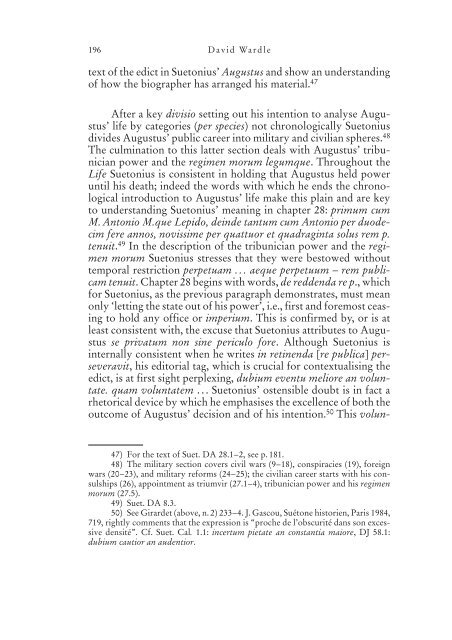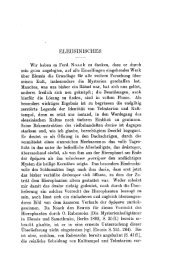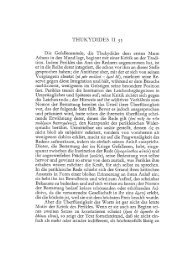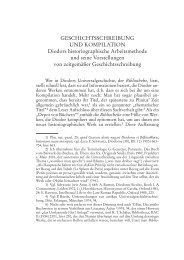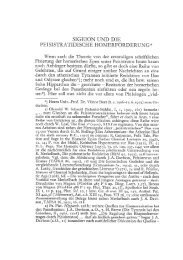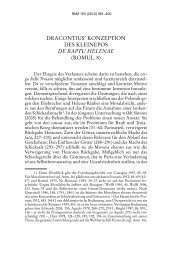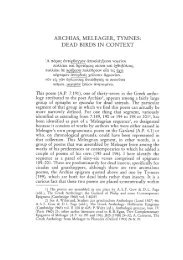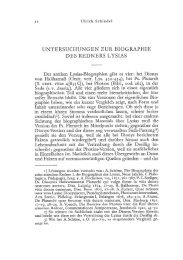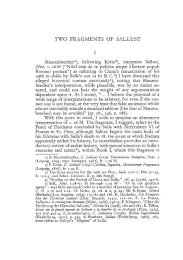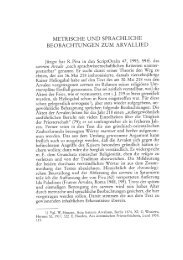VIRGILIO E STESICORO Una ricerca sulla Tabula Iliaca Capitolina *
VIRGILIO E STESICORO Una ricerca sulla Tabula Iliaca Capitolina *
VIRGILIO E STESICORO Una ricerca sulla Tabula Iliaca Capitolina *
Sie wollen auch ein ePaper? Erhöhen Sie die Reichweite Ihrer Titel.
YUMPU macht aus Druck-PDFs automatisch weboptimierte ePaper, die Google liebt.
196 David Wardle<br />
text of the edict in Suetonius’ Augustus and show an understanding<br />
of how the biographer has arranged his material. 47<br />
After a key divisio setting out his intention to analyse Augustus’<br />
life by categories (per species) not chronologically Suetonius<br />
divides Augustus’ public career into military and civilian spheres. 48<br />
The culmination to this latter section deals with Augustus’ tribunician<br />
power and the regimen morum legumque. Throughout the<br />
Life Suetonius is consistent in holding that Augustus held power<br />
until his death; indeed the words with which he ends the chronological<br />
introduction to Augustus’ life make this plain and are key<br />
to understanding Suetonius’ meaning in chapter 28: primum cum<br />
M. Antonio M.que Lepido, deinde tantum cum Antonio per duodecim<br />
fere annos, novissime per quattuor et quadraginta solus rem p.<br />
tenuit. 49 In the description of the tribunician power and the regimen<br />
morum Suetonius stresses that they were bestowed without<br />
temporal restriction perpetuam . . . aeque perpetuum – rem publicam<br />
tenuit. Chapter 28 begins with words, de reddenda re p., which<br />
for Suetonius, as the previous paragraph demonstrates, must mean<br />
only ‘letting the state out of his power’, i.e., first and foremost ceasing<br />
to hold any office or imperium. This is confirmed by, or is at<br />
least consistent with, the excuse that Suetonius attributes to Augustus<br />
se privatum non sine periculo fore. Although Suetonius is<br />
internally consistent when he writes in retinenda [re publica] perseveravit,<br />
his editorial tag, which is crucial for contextualising the<br />
edict, is at first sight perplexing, dubium eventu meliore an voluntate.<br />
quam voluntatem ... Suetonius’ ostensible doubt is in fact a<br />
rhetorical device by which he emphasises the excellence of both the<br />
outcome of Augustus’ decision and of his intention. 50 This volun-<br />
47) For the text of Suet. DA 28.1–2, see p. 181.<br />
48) The military section covers civil wars (9–18), conspiracies (19), foreign<br />
wars (20–23), and military reforms (24–25); the civilian career starts with his consulships<br />
(26), appointment as triumvir (27.1–4), tribunician power and his regimen<br />
morum (27.5).<br />
49) Suet. DA 8.3.<br />
50) See Girardet (above, n. 2) 233–4. J. Gascou, Suétone historien, Paris 1984,<br />
719, rightly comments that the expression is “proche de l’obscurité dans son excessive<br />
densité”. Cf. Suet. Cal. 1.1: incertum pietate an constantia maiore, DJ 58.1:<br />
dubium cautior an audentior.


